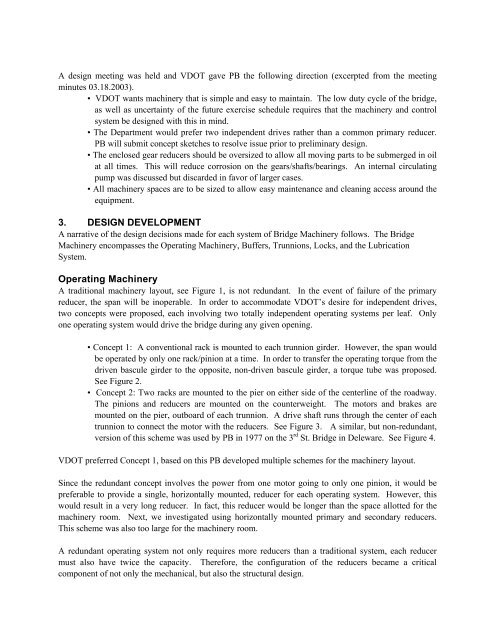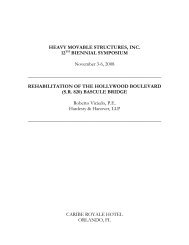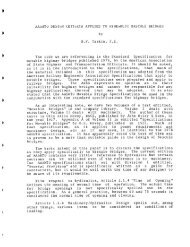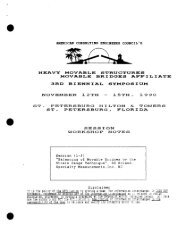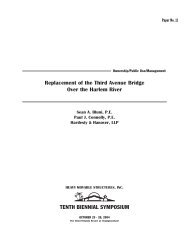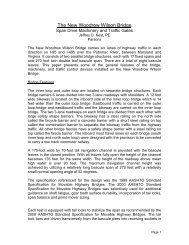Route 33 Over Pamunkey River, West Point, VA - Heavy Movable ...
Route 33 Over Pamunkey River, West Point, VA - Heavy Movable ...
Route 33 Over Pamunkey River, West Point, VA - Heavy Movable ...
- No tags were found...
You also want an ePaper? Increase the reach of your titles
YUMPU automatically turns print PDFs into web optimized ePapers that Google loves.
A design meeting was held and VDOT gave PB the following direction (excerpted from the meetingminutes 03.18.2003).• VDOT wants machinery that is simple and easy to maintain. The low duty cycle of the bridge,as well as uncertainty of the future exercise schedule requires that the machinery and controlsystem be designed with this in mind.• The Department would prefer two independent drives rather than a common primary reducer.PB will submit concept sketches to resolve issue prior to preliminary design.• The enclosed gear reducers should be oversized to allow all moving parts to be submerged in oilat all times. This will reduce corrosion on the gears/shafts/bearings. An internal circulatingpump was discussed but discarded in favor of larger cases.• All machinery spaces are to be sized to allow easy maintenance and cleaning access around theequipment.3. DESIGN DEVELOPMENTA narrative of the design decisions made for each system of Bridge Machinery follows. The BridgeMachinery encompasses the Operating Machinery, Buffers, Trunnions, Locks, and the LubricationSystem.Operating MachineryA traditional machinery layout, see Figure 1, is not redundant. In the event of failure of the primaryreducer, the span will be inoperable. In order to accommodate VDOT’s desire for independent drives,two concepts were proposed, each involving two totally independent operating systems per leaf. Onlyone operating system would drive the bridge during any given opening.• Concept 1: A conventional rack is mounted to each trunnion girder. However, the span wouldbe operated by only one rack/pinion at a time. In order to transfer the operating torque from thedriven bascule girder to the opposite, non-driven bascule girder, a torque tube was proposed.See Figure 2.• Concept 2: Two racks are mounted to the pier on either side of the centerline of the roadway.The pinions and reducers are mounted on the counterweight. The motors and brakes aremounted on the pier, outboard of each trunnion. A drive shaft runs through the center of eachtrunnion to connect the motor with the reducers. See Figure 3. A similar, but non-redundant,version of this scheme was used by PB in 1977 on the 3 rd St. Bridge in Deleware. See Figure 4.VDOT preferred Concept 1, based on this PB developed multiple schemes for the machinery layout.Since the redundant concept involves the power from one motor going to only one pinion, it would bepreferable to provide a single, horizontally mounted, reducer for each operating system. However, thiswould result in a very long reducer. In fact, this reducer would be longer than the space allotted for themachinery room. Next, we investigated using horizontally mounted primary and secondary reducers.This scheme was also too large for the machinery room.A redundant operating system not only requires more reducers than a traditional system, each reducermust also have twice the capacity. Therefore, the configuration of the reducers became a criticalcomponent of not only the mechanical, but also the structural design.


